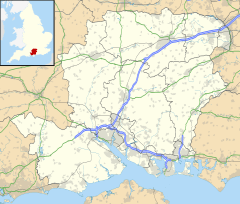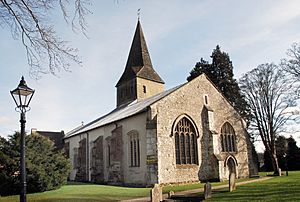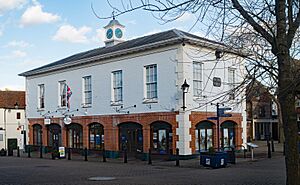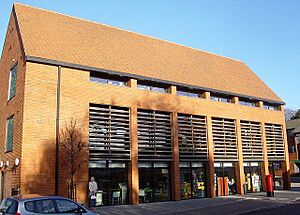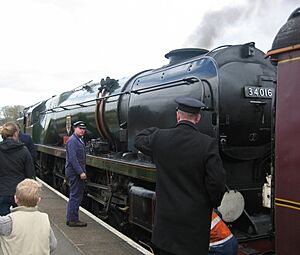Alton, Hampshire facts for kids
Quick facts for kids Alton |
|
|---|---|
| Town | |
 Alton, looking north east along the High Street |
|
| Population | 19,425 (2021 Census) |
| OS grid reference | SU716394 |
| Civil parish |
|
| District |
|
| Shire county | |
| Region | |
| Country | England |
| Sovereign state | United Kingdom |
| Post town | ALTON |
| Postcode district | GU34 |
| Dialling code | 01420 |
| Police | Hampshire |
| Fire | Hampshire |
| Ambulance | South Central |
| EU Parliament | South East England |
| UK Parliament |
|
Alton is a busy market town in East Hampshire, England. It's located near where the northern part of the River Wey begins. In 2021, about 19,425 people lived here.
Alton was first written about in 1086 as Aoltone in the Domesday Survey. Long ago, during the Saxon times, it was called Aweltun. A big battle happened here during the English Civil War. Alton is also connected to famous people like Jane Austen, a well-known writer.
Contents
History of Alton
Ancient Times
In 1996, a collection of old Iron Age coins and jewelry, called the Alton Hoard, was found near the town. You can see these items at the British Museum today.
Long ago, the Romans had a stopping place called Vindomis near Alton. It was on a Roman road that went from Chichester to Silchester. An Anglo-Saxon village also grew here. When people were digging for new buildings, they found a 7th-century cemetery. Inside, they found special items like the Alton Buckle. This buckle is considered one of the best Anglo-Saxon artworks found in Hampshire. It's made of silver and gold, with red stones and glass. You can see it at the Curtis Museum.
The name Alton comes from an old Anglo-Saxon word, "aewielltun". This means "farmstead at the source of the river", because the River Wey starts in the town.
In 1001, Danish forces attacked England. The people of Wessex fought them in the First Battle of Alton. Many English soldiers were killed, but the Danes also lost many men.
Alton was known for having a very important market in the Domesday Book of 1086.
Medieval Period
In 1101, an important agreement called the Treaty of Alton was signed here. It was between William the Conqueror's oldest son, Robert II of Normandy, and his brother, Henry I of England. Henry had taken the throne while Robert was away. They met in Alton and agreed on terms. A street in Alton is still called Normandy Street, likely because of this event.
Alton has had markets for a very long time. The first market was recorded in 1232. These markets were important places where people bought and sold food, animals, and other goods. Over time, the types of goods sold changed. In the 18th century, you could find lace, gloves, books, and even gingerbread.
Today, Alton still has an annual fair, but it's now a fun carnival with rides and entertainment.
More Recent History
Eggar's School was started in 1640 as a free school. It moved to a new location in Holybourne in 1969.
A battle happened in Alton during the English Civil War. On December 13, 1643, a small group of Royalist soldiers were surprised by a much larger Parliamentary army. The Royalist horse soldiers ran away. Sir Richard Bolle and his foot soldiers were left to fight. They were forced into the Church of St Lawrence. Many Royalists, including Sir Richard, were killed. Over 700 Royalist soldiers were captured. You can still see bullet holes from the battle in the church walls today.
In 1665, Alton had an outbreak of the bubonic plague, but the town recovered quickly.
In 1867, a sad event happened when an eight-year-old girl named Fanny Adams was murdered in Alton. The person responsible was caught and punished. Her grave is still in Alton cemetery. This event led to a saying, "Sweet Fanny Adams," which means "nothing." It started when sailors didn't like new tinned meat and joked that the tins contained "Sweet Fanny Adams."
How Alton is Governed
Alton is run by the Alton Town Council. This council was created in 1974. It works with the Hampshire County Council and the East Hampshire District Council to manage local services. The Town Council meets at Alton Town Hall in Market Square.
Geography of Alton
Alton is about 9 miles (14 km) northeast of Farnham and 16 miles (26 km) southwest of Winchester. London is about 52 miles (84 km) away.
Nearby, Brockham Hill is about 3.5 miles (5.6 km) northeast of Alton. It rises to 225 meters (738 feet) above sea level.
Climate
Alton has a mild climate, like the rest of South East England. It's generally warmer than other parts of the country. The average yearly temperature is about 9°C (48°F). January is the coldest month, and June and July are the warmest, with temperatures around 21°C (70°F).
Alton's Economy
Alton has been home to breweries since 1763. Coors Brewing Company, a very large brewery, had a factory in Alton for 50 years. It made popular beers like Carling and Grolsch. The brewery closed in 2015.
In the 18th century, Alton was known for making paper and different kinds of fabrics.
Today, Alton has many shops and businesses in the town center. There are also over a hundred businesses in four industrial areas. These businesses do everything from light manufacturing to creating computer software.
Some big companies have offices in Alton's industrial areas. For example, Clarcor and TNT N.V. have businesses here.
One of the biggest employers in Alton is the financial services industry. Inter Group Insurance Services (IGIS), which is part of the Royal Bank of Scotland, used to have an office here. They specialized in travel insurance. The company closed its Alton office in 2009.
Alton has a mix of well-known chain stores and local independent shops. You can find greengrocers, butchers, and hardware stores. There are also five main supermarkets in the town.
Culture and Arts
The Jane Austen Regency Week celebrates the time the famous author Jane Austen spent in Alton and Chawton. It happens every June.
The Allen Gallery is Alton's art gallery. It has a large collection of ceramics and also hosts new art shows.
Holybourne Theatre is a unique theater. It was once a military hut that German prisoners-of-war turned into a theater during World War II. Plays have been performed there since 1950.
Alton Morris is a group formed in 1979 that performs Morris dancing. They dance in the UK and other countries, often at Alton's street events.
Alton has several local choirs. The Alton Amateur Operatic and Dramatic Society performs musicals and plays. The Alton Community Choir sings folk songs and other styles like gospel and blues.
A new Alton Arts Festival is planned for July 2024, lasting for 10 days.
Important Places to See
The Alton Independent Cinema Project started in 2011 to help keep independent movies playing in town.
Alton Maltings was updated in 2004–2005. It is now home to Harvest Church and is used by many community groups. It is said to be the widest wooden building in Hampshire.
Alton Library was rebuilt in 2005. The new library has books to borrow, a reference section, computers, and a cafe.
Alton Sports Centre is open to everyone. It has a swimming pool, a gym, and courts for different sports.
The Curtis Museum was started in 1856. It has one of the best collections of local history items in Hampshire.
The Town Gardens has a bandstand built in 1935. It also has a playground, flower beds, and trees. The bandstand was replaced in 2013.
Anstey Park is a large open space with playing fields and a small playground. It's home to the town's rugby club.
Sports
Alton F.C., also known as the Brewers, is Alton's football team. As of the 2024/25 season, they play in the 9th tier of English Football.
Education
Alton is located between the University of Winchester and the University of Surrey in Guildford. The closest university campus is the University for the Creative Arts in Farnham.
Alton is home to Treloar's, a special school founded in 1907. It helps young people aged 2–25 with physical and learning disabilities.
The public secondary schools in Alton are Eggar's School and Amery Hill School. There is also a private Catholic school, Alton School, for boys and girls from 6 months to 18 years old. For older students, Alton College provides Sixth-form education and has received excellent reports.
Transport
Alton station is part of the National Rail network. You can take a train from here to London Waterloo.
Alton station is also the end point for the Watercress Line. This is a restored steam railway that runs between Alton and New Alresford. It's called the Watercress Line because it used to carry fresh watercress to London. Today, it's a charity run by volunteers and is famous for events like Steam Illuminations and Day Out With Thomas.
The Watercress Line started in 1861. It was closed in 1973 but later reopened in parts. By 1985, it was fully re-opened to Alton, connecting with the main train service to London.
In the past, Alton was a railway junction. Other railway lines, like the Meon Valley Railway and the Basingstoke & Alton Light Railway, also ran from Alton.
Buses in Alton are run by Stagecoach South. You can take buses to places like Winchester, Guildford, Basingstoke, and Petersfield.
Notable People
- Jane Austen (1775–1817), a famous writer, lived in Chawton near Alton from 1809 until she passed away. She wrote or updated six of her novels there.
- Cardinal Newman (1801–1890), an important English Catholic figure, lived in Alton from 1816 to 1819.
- Russell Howard (born 1980), a well-known comedian, studied in Alton.
- Alison Goldfrapp (born 1966), a singer in the band Goldfrapp, went to school in Alton.
- Samantha Warriner (born 1971), a retired triathlete who represented New Zealand, was born in Alton.
Twin towns
Alton is connected with these towns:
- Pertuis, France
- Montecchio Maggiore, Italy
See also
 In Spanish: Alton (Hampshire) para niños
In Spanish: Alton (Hampshire) para niños


